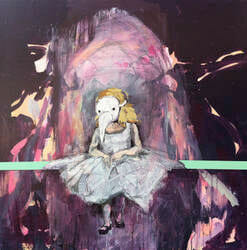Essay to accompany the exhibit Kellesimone Waits: Antithesis. Held at the Linder Gallery, Keystone College, March 24-April 30, 2013.

For as long as there has been art, people have been turning that hard nut of a question, “what is art for?” over and over again. To the ethnologist Ellen Dissanayake, the purpose of art has much to do with the human need to “make special,” that is, to take things out of their ordinariness and enhance them aesthetically. Such things include the places we live, the tools we use, the clothes we wear, the food we eat, and the bodies we inhabit. They also include the tasks and events that occupy our time, the noises we make, the words we write and speak, and the movements we perform. To the artistic spirit, all of these things (and more)yearn to be made special, and subsequently, to make the experience of those who witness them special, too.
In creating this specialness, however, another kind of “making” often takes place, the kind expressed by that odd pairing of verbs, to make believe. Indeed, artists excel at making others believe in the fictions they create, or as Picasso famously said, in the “lie that reveals the truth.” But artists, of course, are not the only people who imagine and pretend. Make believe is one ability we master as children, and most of us continue to pretend long after childhood ends. In so doing, we mythologize our lives, and through that mythology come to manage the often hard scrabble world in which we live.
Kellesimone Waits’ most recent paintings explore this relationship between fantasy and reality, and how it defines our understanding of the world. The idea that fantasy could not exist without reality because there would be nothing from which to escape, and that reality, through its bluntness and mundanity, compels us to dream and to pretend, is central to her work.

More deeply though, Waits explores the tension between fantasy and reality, and how they sometimes pull us in opposite directions. A work such as Dancing the Line, for instance, alludes to this tension. The mask the figure wears and even the act of dancing itself are the indulgences of fantasy, yet the dancer holds the line, not allowing herself to fall to either side. In this balance of desires, Waits suggests, between fantasy and everyday reality, a new phenomenon might also emerge, a kind of Hegelian synthesis of the extremes. It is enough to make us wonder what it’s like to be dancing on that line. Of course, dancers are artists, and artists of all types must negotiate between the desire to indulge in flights of fancy and to ground themselves by coming back to earth. In that balance, the best art frequently occurs. Artists like Kellesimone Waits, I think, seek this tension, and her paintings are about that experience, as well. It’s not exactly make believe and it might not be reality, but it is, perhaps, something closer to the truth.
